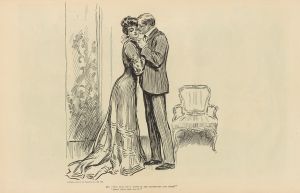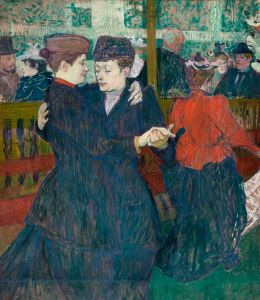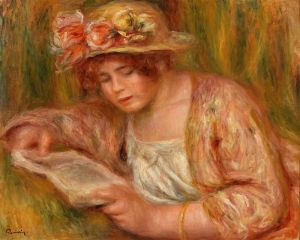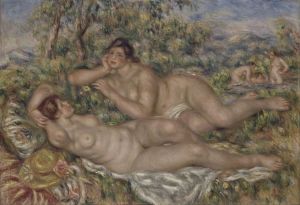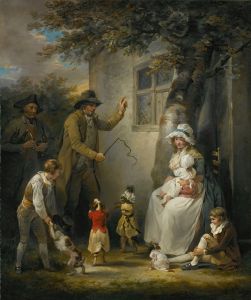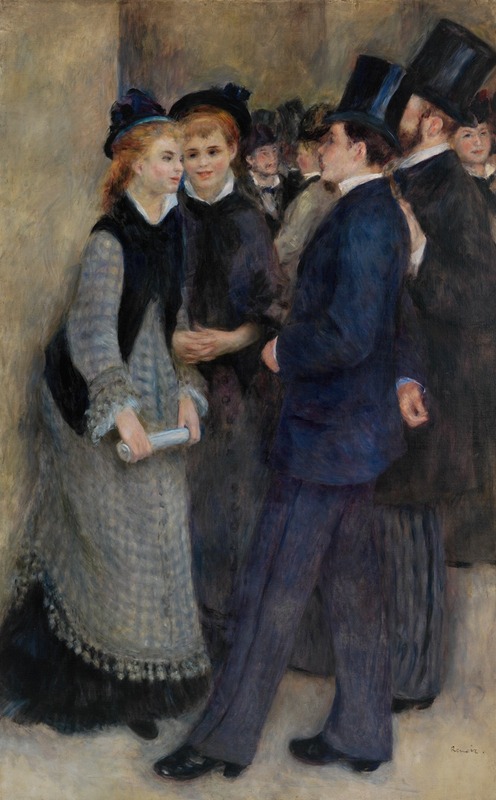
Leaving the Conservatory
A hand-painted replica of Pierre-Auguste Renoir’s masterpiece Leaving the Conservatory, meticulously crafted by professional artists to capture the true essence of the original. Each piece is created with museum-quality canvas and rare mineral pigments, carefully painted by experienced artists with delicate brushstrokes and rich, layered colors to perfectly recreate the texture of the original artwork. Unlike machine-printed reproductions, this hand-painted version brings the painting to life, infused with the artist’s emotions and skill in every stroke. Whether for personal collection or home decoration, it instantly elevates the artistic atmosphere of any space.
Pierre-Auguste Renoir, a leading figure in the Impressionist movement, is renowned for his vibrant light and saturated color, often focusing on people in intimate and candid compositions. One of his notable works is "Leaving the Conservatory" (French: "La Sortie du Conservatoire"), which exemplifies his skill in capturing the nuances of human interaction and the subtleties of light and shadow.
"Leaving the Conservatory" was painted in 1876, a period when Renoir was deeply involved with the Impressionist group, which sought to break away from the traditional approaches of the French Academy. This painting reflects the Impressionist interest in modern life and the fleeting moments of everyday experiences. Renoir's work during this time often depicted scenes of leisure and social gatherings, capturing the essence of Parisian life in the late 19th century.
The painting portrays a group of young women exiting a conservatory, likely a music or dance school, given the context of the era and Renoir's interest in such themes. The scene is set outdoors, with the figures bathed in natural light, a hallmark of Impressionist art. Renoir's brushwork is loose and fluid, allowing the colors to blend softly into one another, creating a sense of movement and life. This technique helps convey the spontaneity of the moment, as if the viewer is witnessing the scene unfold in real-time.
Renoir's use of color in "Leaving the Conservatory" is particularly noteworthy. He employs a palette of soft pastels and vibrant hues, which not only highlights the figures but also integrates them into the surrounding environment. The play of light and shadow across the figures and the background adds depth and dimension to the composition, enhancing the realism of the scene while maintaining the dreamlike quality characteristic of Impressionist works.
The figures in the painting are depicted with a sense of grace and elegance, reflecting Renoir's admiration for beauty and his ability to capture the charm of his subjects. The young women are dressed in the fashion of the time, their attire suggesting a sense of refinement and sophistication. Renoir's attention to detail in rendering the textures of the fabric and the subtle expressions on the women's faces demonstrates his keen observational skills and his ability to convey emotion through his art.
"Leaving the Conservatory" is a testament to Renoir's mastery of the Impressionist style and his dedication to capturing the beauty of everyday life. The painting not only showcases his technical prowess but also his ability to evoke a sense of warmth and intimacy in his work. Through this piece, Renoir invites the viewer to appreciate the simple yet profound moments that make up the human experience.
Today, "Leaving the Conservatory" is celebrated as an important work in Renoir's oeuvre, exemplifying the artist's contribution to the Impressionist movement and his enduring influence on the art world. The painting continues to be admired for its exquisite portrayal of light, color, and human interaction, embodying the essence of Impressionism and Renoir's unique artistic vision.







